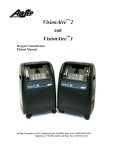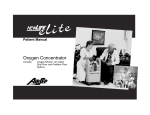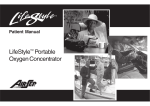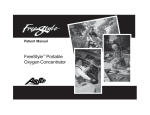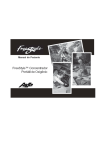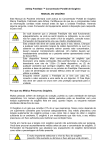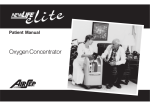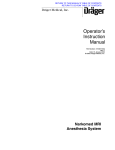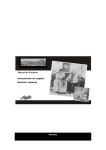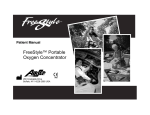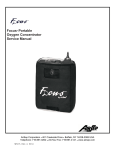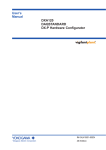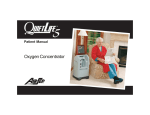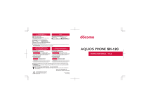Download VisionAire 5 Patient Manual
Transcript
VisionAire™ Oxygen Concentrator Patient Manual AirSep Corporation • 401 Creekside Drive • Buffalo, New York 14228-2085 USA Telephone: (716) 691-0202 • 24-Hour Fax (716) 691-4141 DO NOT OPERATE THIS EQUIPMENT WITHOUT FIRST READING AND UNDERSTANDING THIS MANUAL. IF YOU ARE UNABLE TO UNDERSTAND THE WARNINGS AND INSTRUCTIONS, CONTACT YOUR EQUIPMENT PROVIDER BEFORE ATTEMPTING TO USE THIS EQUIPMENT; OTHERWISE, INJURY OR DAMAGE MAY RESULT. Smoking while using oxygen is the number one cause of fire, injury, and death. You must follow these safety warnings: Do not allow smoking, candles, or open flames within the same room of the device or the oxygen-carrying accessories. Smoking while wearing an oxygen cannula may result in facial burns and possibly death. Removing the cannula and placing it on surfaces such as bedding, sofas, or other cushion material will cause a flash fire when exposed to a cigarette, heat source, or flame. If you smoke, you must follow these 3 life-saving steps: turn off the oxygen concentrator, take off the cannula, and leave the room where this device is located. “No Smoking – Oxygen in Use” signs must be prominently displayed in the home, or where the oxygen concentrator is in use. Patients and their caregivers must be informed about the dangers of smoking in the presence of, or while using, medical oxygen. [Read the Important Safety Rules section before operating this equipment.] Important Safety Rules Page 1-4 Section 1 Introduction Why Your Physician Prescribed Oxygen What is an Oxygen Concentrator? Operator Profile Page 5 Page 5 Page 5 Page 6 Section 2 Concentrator Components 2.1 Front of Concentrator 2.2 Back of Concentrator 2.3 Humidifier Bottle 2.4 Accessories 2.5 Materials in direct or indirect contact with the patient 2.6 Safety Features Page 7 Page 7-8 Page 9 Page 10 Page 10 Section 3 How to Operate Your Oxygen Concentrator 3.1 Humidifier Bottle Connection 3.2 Cannula Connection 3.3 Starting the Concentrator 3.4 Turning the Concentrator Off Page 12 Page 12 Page 12 Page 12 Page 13 Section 4 Care and Cleaning 4.1 Humidifier Bottle 4.2 Outside Cabinet Page 14 Page 14 Page 14 Section 5 Troubleshooting Page 15-16 Section 6 Product Specifications Page 17-20 Section 7 Symbols/Abbreviations Page 21 Section 8 Conformity with EN 60-601 (§ § 6.8.2 b): Classification Page 23 Page 11 Page 11 English: A multilingual version of the manual is available through your equipment provider. Español: Una versión multilingüe del manual está disponible a través de su proveedor de equipo. Français: Une version multilingue du manuel est disponible par l'intermédiaire de votre fournisseur de matériel. Deutsche: Eine mehrsprachige Version des Handbuchs ist in Ihrer Geräte-Anbieter. i MN136-1 rev H 7/13 [Read the Important Safety Rules section before operating this equipment.] Important Safety Rules Carefully review and familiarize yourself with the following important safety information about the VisionAire™ Oxygen Concentrator. This device supplies high-concentration oxygen that promotes rapid burning. Do not allow smoking or open flames within the same room of (1) this device, or (2) any oxygen-carrying accessory. Failure to observe this warning can result in severe fire, property damage and / or cause physical injury or death. This unit is not to be used for life-support. Geriatric, pediatric, or any other patient unable to communicate discomfort while using this oxygen concentrator may require additional monitoring. Patients with hearing and/or sight impairments may need assistance with monitoring the alarms. If you feel discomfort or are experiencing a medical emergency, seek medical assistance immediately. Use no oil, grease, or petroleum-based or other flammable products on or near nasal end of cannula or on the unit. Oxygen accelerates the combustion of flammable substances. Electrical shock hazard. Disconnect the power cord from the electric outlet before you clean the unit to prevent accidental electrical shock and burn hazard. Only your Equipment Provider or a qualified service technician should remove the covers or service the unit. Do not leave a nasal cannula under bed coverings or chair cushions. If the unit is turned on but not in use, the oxygen will make the material flammable. Set the I/0 power switch to the 0 (off) position when the VisionAire unit is not in use. Do not use extension cords with this unit or connect too many plugs into the same electrical outlet. This can result in an overload to the electrical panel causing the breaker/fuse to activate. 1 MN136-1 rev H [Read the Important Safety Rules section before operating this equipment.] Use only voltage specified on back panel label. Do not use your oxygen concentrator in the presence of flammable gases. This can result in rapid burning causing property damage, bodily injuries or death. Care should be taken to prevent unit from getting wet or allowing water to enter the unit. This can cause the unit to malfunction or shut down, and cause an increased risk for electrical shock or burns. Disconnect the power cord from the electrical outlet before you clean the unit to prevent accidental electrical shock hazards. Only your Equipment Provider or a qualified service technician should remove the covers or service the unit. Do not use liquid directly on the unit. A list of undesirable chemical agents includes but is not limited to the following: alcohol and alcohol-based products, concentrated chlorine-based products (ethylene chloride), and oilbased products (Pine-Sol®, Lestoil®). These are NOT to be used to clean the plastic housing on the unit , as they can damage the unit’s plastic. Clean the cabinet, control panel, and power cord only with a mild household cleaner applied with a damp cloth or sponge, and then wipe all surfaces dry. Do not allow any liquid to get inside the device. No modification of this equipment is allowed. The unit should not be used adjacent to or stacked with other equipment. If adjacent or stacked use is unavoidable, the device should be observed to verify normal operation. Federal (USA) law restricts this device to sale or rental by order of a physician or other licensed health care provider. 2 MN136-1 rev H [Read the Important Safety Rules section before operating this equipment.] AirSep recommends an alternate source of supplemental oxygen in the event of a power outage, alarm condition, or mechanical failure. Consult your physician or Equipment Provider for the type of reserve system required. It is very important to follow the prescribed level of oxygen flow. Do not increase or decrease the flow until you first consult your physician. Ensure concentrator is operated in an upright position. Position the unit away from curtains or drapes, hot air registers or heaters. Be certain to place the unit on a flat surface and make sure all sides are at least 1 foot (30 cm) away from a wall or other obstruction. Do not place the unit in a confined area. Choose a dust and smoke free-location away from direct sunlight. Do not operate the unit outdoors. Do not operate this unit in a restricted or confined space where ventilation can be limited. This can cause the device to overheat and affect performance. In the event of an alarm or you observe the unit is not working properly; consult the troubleshooting section of this manual. If you cannot resolve the problem, consult your Equipment Provider. The Oxygen Concentrator may be used during sleep under the recommendation of a qualified clinician. If the humidifier bottle tubing is not properly connected to the humidifier bottle fitting or to the oxygen outlet, an oxygen leak can occur. Storing the device outside of its temperature specifications may affect performance (refer to the specification section of the manual). Do not position the unit so that it is difficult to access the power cord. 3 MN136-1 rev H [Read the Important Safety Rules section before operating this equipment.] The concentrator should be located as to avoid pollutants or fumes. If oxygen does not seem to flow, first verify that the flowmeter ball is registering a flow. Then, place the tip of the cannula into a glass of water; if bubbles come out of the cannula, oxygen is flowing. If bubbles do not appear, refer to Section 5.0. Troubleshooting. To prevent a voided AirSep warranty, follow all manufacturers’ instructions. Replace the disposable cannula periodically following normal usage according to your Equipment Providers recommendations. AirSep does not recommend the sterilization of this equipment. Do not attempt any maintenance other than the possible solutions listed below. If the unit has not been used for an extended time period, it needs to operate for several minutes before power failure alarm can become activated. Portable and mobile RF communications equipment can affect medical electrical equipment. The concentrator releases warm air out the bottom of the unit which can permanently discolor temperature sensitive flooring surfaces such as vinyl. The concentrator should not be used over flooring that is sensitive to heat staining. AirSep is not responsible for flooring that becomes discolored. “No Smoking - Oxygen in Use” signs must be prominently displayed in the home or where the oxygen concentrator is in use. Patients and their caregivers must be informed about the dangers of smoking in the presence of, or while using, medical oxygen. 4 MN136-1 rev H [Read the Important Safety Rules section before operating this equipment.] 1.0 Introduction This Patient Manual will acquaint you with AirSep’s VisionAire Oxygen Concentrator. Make sure you read and understand all of the information contained in this guide before operating your concentrator. Should you have any questions, your Equipment Provider will be happy to answer them for you. Why Your Physician Prescribed Oxygen Many people today suffer from a variety of heart, lung, and other respiratory diseases. A significant number of these patients can benefit from supplemental oxygen therapy for respiratory care at home, in the hospital, or at a medical facility. Oxygen is a gas that makes up 21% of the room air we breathe. Our bodies depend on a steady supply to function properly. Your physician has prescribed supplemental oxygen therapy because your body is not able to get enough oxygen from room air. Oxygen is a non-addictive drug, and your physician prescribed a flow sufficient to improve your condition. Please keep in mind that unauthorized oxygen therapy can be dangerous. You must seek medical advice before you use this unit. The Equipment Provider who supplies your oxygen equipment will demonstrate how to set the prescribed flow rate. What is an Oxygen Concentrator? Oxygen concentrators were introduced in the mid-1970s and have become the most convenient, reliable source of supplemental oxygen available today. Without an oxygen concentrator, the average patient would require a delivery of 12 bottles/cylinders of oxygen each month. Your oxygen concentrator produces all the oxygen you need, with no deliveries required. The air we breathe contains approximately 21% oxygen, 78% nitrogen, and 1% other gases. In the VisionAire unit, room air passes through a regenerative adsorbent material called molecular sieve. This material separates the oxygen from the nitrogen and other gases. The result is a constant supply of high concentration supplemental oxygen that is delivered to the patient. Note: There is never a danger of depleting the oxygen in a room when you use your VisionAire unit. 5 MN136-1 rev H [Read the Important Safety Rules section before operating this equipment.] Operator Profile: AirSep’s Stationary Concentrators are intended to supply supplemental Oxygen to users suffering from discomfort due to ailments which affect the efficiency of ones lungs to transfer the oxygen in air to their bloodstream. Users can benefit from supplemental oxygen therapy for respiratory care at home, in the hospital, or at a medical facility. Oxygen Concentrator use requires a physician’s prescription, and are not intended for life support use. Although oxygen therapy can be prescribed for patients of all ages, the typical oxygen therapy patient is older than 65 years of age and suffers from chronic obstructive pulmonary disease (COPD). Patients typically have good cognitive abilities and must be able to communicate discomfort. If the user is unable to communicate discomfort, or unable to read and understand the concentrator labeling and instructions for use, then use is recommended only under the supervision of one who can. If any discomfort is felt while using the concentrator, patients are advised to contact their healthcare provider. Patients are also advised to have back-up oxygen available (i.e. cylinder oxygen) in the event of a power outage or concentrator failure. There are no other unique skills or user abilities required for concentrator use. 6 MN136-1 rev H [Read the Important Safety Rules section before operating this equipment.] 2.0 Concentrator Components Review the figures below and become familiar with the important parts of your VisionAire Oxygen Concentrator. 2.1 Front of Concentrator Top Handle Hour Meter Oxygen Outlet Side Handles Circuit Breaker Reset Button Flowmeter Adjustment Knob ON/OFF (I/0) Power Switch Operating Instructions Label Low Oxygen Concentration Indicator (optional – mandated for EU and specific countries) Caster(s) Figure 1 Specification Label Figure 1a 7 MN136-1 rev H [Read the Important Safety Rules section before operating this equipment.] Ø Top and Side Handles: o Enables convenience in carrying the unit. Ø On/Off (I/0) Power Switch: o Starts and stops the operation of the unit. Ø Oxygen Outlet o Provides connection for a humidifier (if required) or cannula. Ø Circuit Breaker Reset Button: o Resets the unit after electrical overload shutdown Ø Flowmeter Adjustment Knob: o Controls the oxygen flow rate in liters per minute (LPM). Ø Low Oxygen Concentration Indicator (optional – mandated for EU and specific countries) o When equipped with an Oxygen Monitor – a warning LED (amber) is activated on the front panel (see Section 2.6 ‘ Safety Features’ for details) Ø Hour Meter: o Records the concentrator’s cumulative hours of operation. Ø Operating Instructions Label: o Directs usage of the unit. Ø Casters: o Four casters enable unit to be easily moved, as needed. Ø Specification Label: o Displays electrical specifications and serial number. 8 MN136-1 rev H [Read the Important Safety Rules section before operating this equipment.] 2.2 Back of Concentrator Humidifier Bottle Recess Power Cord Figure 2 Ø Power Cord: o Allows connection of the unit to an electrical outlet. Ø Humidifier Bottle Recess: o Area to place the optional humidifier bottle. 9 MN136-1 rev H [Read the Important Safety Rules section before operating this equipment.] 2.3 Humidifier Bottle (optional) Humidifier Bottle Fitting Humidifier Bottle Oxygen Outlet Humidifier Bottle Tubing Humidifier Bottle Oxygen Tubing/Cannula Figure 3 Ø Humidifier Bottle (optional): o Humidifies the oxygen before it reaches the patient. Ø Humidifier Bottle Oxygen Outlet: o Connection for oxygen tubing/cannula. 2.4 Accessories: Recommended for use with VisionAire 2 and VisionAire 3. The use of certain administration accessories which are not specified for use with this concentrator may reduce performance and void the manufacturer’s warranty. Ø Humidifier Bottle o AirSep part number – HU003-1 Ø Cannula, 25 feet (7.6 m) o AirSep part number – CU002-4 Ø Humidifier Bottle Tubing o AirSep part number – TU176-160 Ø Humidifier Bottle Fitting o AirSep part number – F0655-1 Ø Oxygen Tubing, 25 feet (7.6 m) o AirSep part number – CU004-3 Ø Tubing/Cannula Connector o AirSep part number – CU009-1 10 MN136-1 rev H [Read the Important Safety Rules section before operating this equipment.] 2.5 Materials in direct or indirect contact with the patient o Concentrator Cabinet (all parts) …………. NOVA PS6201 Super High Impact Polystyrene o Gas Outlet, Nozzle ………………………. Aluminum, Black Anodized o On / Off Switch ……………………….. DuPont FR50 o Hour Meter …………………………......... Acrylonitrile Butadiene Styrene (ABS) Plastic & Acrylic o Flowmeter ……………………………….. ABS (STAT-TECH AS1000) o Gas outlet ……………………………........Brass o Circuit Breaker …………………………... Button - Melamine or Urea Formaldehyde, Mounting Bushing – Polyamide 66 (Nylon) o Unit Labels ………………………………. Lexan o Power Cord……………………………….. Polyvinyl Chloride (PVC), Metal o Cord Strain relief ………………………… Nylon o Cord Wrap ……………………………….. Velcro o Dust Filter ………………………………... Polyester o Humidifier Strap ……………………......... Yarn, Rubber o Humidifier Bottle ………………………... Top – Acrylonitrile Butadiene Styrene (ABS) ………………………… Bottle – Polypropylene (PP), Diffuser -Polyvinyl Chloride (PVC) o Cannula (Tubing)…………………………Polyvinyl Chloride (PVC), 2.6 Safety Features: Ø Compressor Motor: Thermal safety is ensured by a thermostat situated in the stator winding (135°C / 275 °F). A safety relief valve is fitted to the compressor outlet and is calibrated to 280 kPa (40 psig). Ø Power Failure : In the event the unit is operating and a loss of power occurs, an audible single - pulse intermittent alarm will activate. Ø Oxygen Monitor: The oxygen monitor detects any drop in concentration below 82% (±3%) and activates a visual alarm (amber LED indicator on front panel). If the concentration continues to operate below 82%, an audible 2 pulse intermittent alarm will also activate. Ø Hi Pressure: An over-pressure safety feature prevents potential damage to device components at a pressure of 228 kPa (33 psig (± 2 psig)). An audible 4-pulse intermittent alarm will activate. Ø Low Pressure: An audible 3- pulse intermittent alarm will activate if the device pressure reduces to ≤ 35 kPa (5 psig (± 1 psig)). Ø No Flow Warning : An obstruction to the flow of oxygen, such as a pinch or kink in the delivery cannula, will activate an audible 6- pulse intermittent alarm. Ø Product Filter: ≥ 10 µm filter 11 MN136-1 rev H [Read the Important Safety Rules section before operating this equipment.] 3.0 How To Operate Your Oxygen Concentrator Review the following information before you operate your oxygen concentrator. The concentrator releases warm air out the bottom of the unit which can permanently discolor temperature sensitive flooring surfaces such as vinyl. The concentrator should not be used over flooring that is sensitive to heat staining. AirSep is not responsible for flooring that becomes discolored. 3.1 Humidifier Bottle (Optional) If additional humidification is required with your oxygen therapy, perform the following steps each time you fill or clean the humidifier, which may have been initially set up for your use. 1. Remove the humidifier bottle from the humidifier bottle recess. 2. Open the humidifier bottle. If you have a pre-filled bottle, do not perform this step. Proceed to step 5. 3. Fill the humidifier bottle with cool or cold water (distilled water is preferred) to the fill line indicated on the bottle. DO NOT OVERFILL. 4. Re-connect the top cover to the humidifier bottle. 5. Place the humidifier bottle in the humidifier bottle recess on the back of the concentrator and connect the humidifier bottle tubing to the oxygen outlet and the humidifier bottle fitting. If the humidifier bottle tubing is not properly connected to the humidifier bottle fitting or to the oxygen outlet, an oxygen leak can occur. 3.2 Cannula Connection Connect the tubing and cannula to the unit’s oxygen outlet, or to the optional humidifier’s oxygen outlet. 3.3 Starting the Concentrator NO SMOKING signs must be prominently displayed in the home or wherever unit is in use. Patients and their contacts should be informed about the dangers of smoking in the presence of medical oxygen. Do not use extension cords with this unit or connect too many plugs into the same electrical outlet. This can result in an overload to the electrical panel causing the breaker/fuse to activate. Position the unit away from curtains or drapes, hot air registers or heaters. Be certain to place the unit on a flat surface and make sure all sides are at least 1 foot (30 cm) away from a wall or other obstruction. Do not place the unit in a confined area. Choose a dust and smoke free-location away from direct sunlight. Do not operate the unit outdoors. 12 MN136-1 rev H [Read the Important Safety Rules section before operating this equipment.] 1. Locate the unit near the electrical outlet in the room where you spend most of your time. 2. Insert the power cord plug into the electrical outlet. 3. Set the I/0 power switch to the “I” position to turn the unit on. An audible alarm will loudly sound for approximately 5 seconds. 4. The low oxygen concentration indicator remains on for a few minutes and until the oxygen concentration reaches minimum concentration requirements, (only pertains to unit equipped with an Oxygen Monitor) 5. To set the flow of supplemental oxygen, turn the flowmeter adjustment knob left or right until the ball inside the flowmeter centers on the flow line number prescribed by your physician. To view the flowmeter at the proper angle, note that the back line and the front number line must give appearance of one line. 6. The concentrator is now ready for use. Optimal oxygen concentration is obtained within 10 minutes after the device is switched on (90% of the concentration is obtained after approximately 5 minutes). It is very important to follow the prescribed level of oxygen flow. Do not increase or decrease the flow until you first consult your physician. Normally, you should not need to adjust the flowmeter on your unit. If you turn the flowmeter adjustment knob clockwise, you will decrease and can shut off the flow of oxygen from your unit. If oxygen does not seem to flow, first verify that the flowmeter ball is registering a flow. Then, place the tip of the cannula into a glass of water; if bubbles come out of the cannula, oxygen is flowing. If bubbles do not appear, refer to Section 5.0. Troubleshooting. Ensure concentrator is operated in an upright position. 3.4 Turning the Concentrator Off • Set the I/0 power switch to the “0” position to turn off the unit. 13 MN136-1 rev H [Read the Important Safety Rules section before operating this equipment.] 4.0 Care and Cleaning Disconnect the power cord from the electrical outlet before you clean the unit to prevent accidental electrical shock hazards. Only your Equipment Provider or a qualified service technician should remove the covers or service the unit. Do not use liquid directly on the unit. A list of undesirable chemical agents includes but is not limited to the following: alcohol and alcoholbased products, concentrated chlorine-based products (ethylene chloride), and oil-based products (Pine-Sol®, Lestoil®). These are NOT to be used to clean the plastic housing on the unit, as they can damage the unit’s plastic. Clean the cabinet, control panel, and power cord only with a mild household cleaner applied with a damp cloth or sponge, and then wipe all surfaces dry. Do not allow any liquid to get inside the device. Replace the disposable cannula periodically following normal usage according to your Equipment Providers recommendations. To prevent a voided AirSep warranty, follow all manufacturers’ instructions. AirSep does not recommend the sterilization of this equipment. 4.1 Humidifier Bottle (optional) • • 4.2 Check water level daily and add water as needed To clean and disinfect the humidifier, follow your Equipment Provider’s instructions, or the instructions included with the humidifier bottle. Outside Cabinet Use a mild household cleaner applied with a damp cloth or sponge to clean the exterior of the concentrator, and then wipe all surfaces dry. Do not allow any liquid to get inside the device. 14 MN136-1 rev H [Read the Important Safety Rules section before operating this equipment.] 5.0 Troubleshooting If your concentrator fails to operate properly, consult your Equipment Provider, and refer to the troubleshooting chart on the following pages for probable causes and solutions. Do not attempt any maintenance other than the possible solutions listed below. If the unit has not been used for an extended time period, it needs to operate for several minutes before power failure alarm can become activated. Problem Unit does not operate. Power failure condition causes an alarm to sound. Probable Cause Solution The power cord is not connected to the electrical outlet. Check power cord at the electrical outlet for a proper connection. Check power source, wall switch, inhouse fuse or circuit breaker. No power at the electrical outlet. Press (do not hold in) the circuit breaker reset button in the front of the unit. Circuit breaker on concentrator unit is activated. Limited or no oxygen flow. If the circuit breaker trips again or the alarm continues to sound after the unit is turned on, contact your Equipment Provider. Remove the humidifier bottle, and if flow is restored, clean or replace the humidifier bottle. Dirty or obstructed humidifier bottle, or leak present. Defective nasal cannula, or other oxygen accessories, i.e. oxygen tubing. Remove and check accessories for kinks or obstructions. Replace if needed. Check cannula tubing connection at control panel. Cannula tubing loose. 15 MN136-1 rev H [Read the Important Safety Rules section before operating this equipment.] Problem Condensation collects in the oxygen tubing when you use a humidifier bottle Intermittent alarm sounds at one second intervals. Probable Cause Unit not properly ventilated. Elevated operating temperatures. Make sure unit is positioned away from curtains or drapes, hot air registers or heaters, Be certain to place the unit so all sides are at least 1 foot (30 cm) away from a wall or other obstruction. Do not place the unit in a confined area. Refill humidifier bottle with COLD water. DO NOT OVERFILL. Allow oxygen tubing to dry out, or replace with new tubing. See section 2.6 ‘Safety Features’ for a description of auditory indicators. Set I/0 power switch to 0 position, use your reserve oxygen supply (if provided), and consult your Equipment Provider immediately. Set I/0 power switch to the 0 position, use your reserve oxygen supply (if provided), and consult your Equipment Provider immediately. Set I/0 power switch to the 0 position, use your reserve oxygen supply (if provided), and consult your Equipment Provider immediately. All other problems. Oxygen Concentration Indicator remains lit (amber) Solution Oxygen concentration is ≤82% (±3%). 16 MN136-1 rev H [Read the Important Safety Rules section before operating this equipment.] 6.0 Product Specifications VisionAire™ Oxygen Concentrator 1 lpm – 5 lpm Flow Specifications(1) ±10% of indicated setting, or 200 mL, whichever is greater(1) Oxygen Concentration(1) 90% (+ 5.5% / - 3%) Electrical Requirements 115 VAC / 60 Hz, 3.0A 230VAC /50 Hz, 1.5A 230VAC / 60 Hz, 1.5A 290 Watts Power Consumption Sound 40 dBa Dimensions 14.1 in. W x 11.5 in. D x 20.8 in. H (35.8 cm W x 29.2 cm D x 52.8 cm H) Weight 30 lbs (13.6 kg) Electrical Shock Protection Class II, Type B Operating conditions: 5 oC to 40 oC (41 oF to 105 oF ) at Environmental Limit Conditions (2) altitudes up to 10,000 ft.(523mmHg) above sea level. Storage: -20 oC - 60 oC (-4°F - 140°F) Relative Humidity: up to 95% RH (non – condensing) (1) Based on 21°C (70°F) at a nominal operating pressure range of 0-7 kPa (0-1 psig back pressure). Maximum output pressure: 55 kPa (7.98 psig) (2) Operating outside of these operational specifications can limit the concentrator's ability to meet Oxygen Concentration specification at higher liter flow rates. . 17 MN136-1 rev H [Read the Important Safety Rules section before operating this equipment.] Specifications continued” Medical equipment needs special precautions regarding EMC and needs to be installed and put into service according to the EMC information provided in this section. Guidance and manufacturer’s declaration ± electromagnetic immunity The VisionAire is intended for use in the electromagnetic environment specified below. The customer or the user of the VisionAire should assure that it is used in such an environment. IEC 60601 test level IMMUNITY test Electrostatic discharge (ESD) Electromagnetic environment guidance Compliance level ± ± 6 kV contact ± 6 kV contact ± 8 kV air ± 8 kV air Floors should be wood, concrete or ceramic tile. If floors are covered with synthetic material, the relative humidity should be at least 30 %. Electrical fast transient/burst ± 2 kV for power supply lines ± 2 kV for power supply lines Mains power quality should be that of a typical commercial or hospital environment. IEC 61000-4-4 ± 1 kV for input/output lines Not Applicable Surge ± 1 kV line to line ± 1 kV line to line IEC 61000-4-5 ± 2 kV line to earth ± 2 kV line to earth Voltage dips, short interruptions and voltage variations on power. <5 % U T (>95 % dip in for 0,5 cycle <5 % U T (>95 % dip in for 0,5 cycle IEC 61000-4-2 IEC 61000-4-11 Power frequency magnetic field 40 % U T (60 % dip in for 5 cycles U T) U T) 40 % U T (60 % dip in for 5 cycles UT) 70 % U T (30 % dip in U T ) for 25 cycles <5 % U T (>95 % dip in for 5s <5 % U T (>95 % dip in for 5 s 3 A/m Mains power quality should be that of a typical commercial or hospital environment. If the user of the VisionAire requires continued operation during power mains interruptions, it is recommended that the VisionAire be powered from an uninterruptible power supply (UPS) or a battery. U T) 70 % U T (30 % dip in U T ) for 25 cycles U T) Mains power quality should be that of a typical commercial or hospital environment. U T) 3 A/m Power frequency magnetic fields should be at levels characteristic of a typical location in a typical commercial or hospital environment. IEC 61000-4-8 NOTE U T is the a.c. mains voltage prior to application of the test level. 18 MN136-1 rev H [Read the Important Safety Rules section before operating this equipment.] Guidance and manufacturer’s declaration ± electromagnetic immunity The VisionAire is intended for use in the electromagnetic environment specified below. The customer or the user of the VisionAire should assure that it is used in such an electromagnetic environment. IMMUNITY test IEC 60601 TEST LEVEL Conducted RF IEC 3 Vrms 61000-4-6 150 kHz to 80 MHz Compliance level 3 Vrms Electromagnetic environment ± guidance Portable and mobile RF communications equipment should be used no closer to any part of the VisionAire including cables, than the recommended separation distance calculated from the equation applicable to the frequency of the transmitter. Recommended separation distance Radiated RF IEC 3 V/m 61000-4-3 80 MHz to 2.5 GHz 3 V/m D= 1.2 x √P D= 1.2 x √P from 80MHz to 800MHz D= 2.3 x √P from 800MHz to 2.5GHz where P is the maximum output power rating of the transmitter in watts (W) according to the transmitter manufacturer and d is the recommended separation distance in meters (m). Field strengths from fixed RF transmitters, as determined by an electromagnetic site surveya should be less than the compliance level in each frequency range. b Interference may occur in the vicinity of equipment marked with the following symbol: NOTE 1 At 80 MHz and 800 MHz, the higher frequency range applies. NOTE 2 These guidelines may not apply in all situations. Electromagnetic propagation is affected by absorption and reflection from structures, objects and people. a. Field strengths from fixed transmitters, such as base stations for radio (cellular/cordless) telephones and land mobile radios, amateur radio, AM and FM radio broadcast and TV broadcast cannot be predicted theoretically with accuracy. To assess the electromagnetic environment due to fixed RF transmitters, an electromagnetic site survey should be considered. If the measured field strength in the location in which the VisionAire is used exceeds the applicable RF compliance level above, the VisionAire should be observed to verify normal operation. If abnormal performance is observed, additional measures may be necessary, such as re-orienting or relocating the VisionAire. b. Over the frequency range 150 kHz to 80 MHz, field strengths should be less than 3 V/m. 19 MN136-1 rev H [Read the Important Safety Rules section before operating this equipment.] Recommended separation distances between portable and mobile RF communications equipment and the VisionAire The VisionAire is intended for use in an electromagnetic environment in which radiated RF disturbances are controlled. The customer or the user of the VisionAire can help prevent electromagnetic interference by maintaining a minimum distance between portable and mobile RF communications equipment (transmitters) and the VisionAire as recommended below, according to the maximum output power of the communications equipment. Rated maximum output power of transmitter Separation distance according to frequency of transmitter (m) W from 150kHz to 80MHz d= 1.2 x √P from 80MHz to 800MHz d= 1.2 x √P from 800MHz to 2.5GHz d= 2.3 x √P 0.01 0.1 1 10 100 0.12 0.38 1.2 3.8 12 0.12 0.38 1.2 3.8 12 0.23 0.73 2.3 7.3 23 For transmitters rated at a maximum output power not listed above, the recommended separation distance d in meters (m) can be estimated using the equation applicable to the frequency of the transmitter, where P is the maximum output power rating of the transmitter in Watts (W) according to the transmitter manufacturer. NOTE 1 At 80 MHz and 800 MHz, the separation distance for the higher frequency range applies. NOTE 2 These guidelines may not apply in all situations. Electromagnetic propagation is affected by absorption and reflection from structures, objects and people. Guidance and manufacturer’s declaration - electromagnetic emissions The VisionAire is intended for use in the electromagnetic environment specified below. The customer or the user of the VisionAire should assure that it is used in such an environment. Emissions test Compliance RF emissions Group 1 Electromagnetic Environment guidance The VisionAire uses RF energy only for its internal function. Therefore, its RF emissions are very low and are not likely to cause any interference in nearby electronic equipment. CISPR 11 RF emissions Class B CISPR 11 The VisionAire is suitable for use in all establishments, including domestic establishments and those directly connected to the public low-voltage power supply network that supplies buildings used for domestic purposes. Harmonic emissions Class A IEC 61000-3-2 Voltage fluctuations/ flicker emissions Complies IEC 61000-3-3 20 MN136-1 rev H [Read the Important Safety Rules section before operating this equipment.] 7.0 Symbols/Abbreviations Symbols are frequently used on equipment in preference to words with the intention of lessening any possibility of misunderstanding caused by language differences. Symbols can also permit easier comprehension of a concept within a restricted space. The following table is a list of symbols and definitions that may be used with AirSep’s VisionAire Oxygen Concentrator. These symbols are referenced from the appropriate International Electro-technical Commission (IEC) standards: Symbol Description Symbol ON (power switch on) Description OFF (power switch off) No smoking Do not disassemble Type B equipment Consult instructions for use Warning – Describes a hazard or unsafe practice that if not avoided can result in severe bodily injury, death or property damage Caution – Describes a hazard or unsafe practice that if not avoided can result in minor bodily injury or property damage Class II Device Complies with the 93/42/EEC directive drawn up by the approved organization No. 0459 Note – Provides information important enough to emphasize or repeat Safety agency for CAN/CSA C22.2 No. 601.1 M90 for medical electrical equipment Consult the accompanying documents Keep unit and accessories dry Proper disposal of waste of electrical and electronic equipment required Use no oil or grease Oxygen outlet connection to the cannula Do not expose to open flames Caution: Federal law (USA) restricts this for sale or rental by or on the order of a physician or licensed health care provider. Keep in the vertical position Fragile – handle with care Oxygen concentration warning LED See Instructions 21 MN136-1 rev H [Read the Important Safety Rules section before operating this equipment.] Method of disposing of waste: All waste from AirSep’s VisionAire Oxygen Concentrator must be disposed using the appropriate methods specified by local authorities Method for disposing of the device: In order to preserve the environment, the concentrator must be disposed using the appropriate methods specified by local authorities. Cet appareil produit de l’oxygène à concentration élevée, favorisant une combustion rapide. Ne pas permettre de fumer ou des flammes nues dans un rayon de 5 pieds (1,5 mètre) de : (1) cet appareil ou (2) tout accessoire contenant de l’oxygène. Ne pas utiliser de produits à base d’huile, de graisse ou de pétrole sur ou à proximité de l’unité. Déconnecter le cordon d’alimentation de la prise électrique avant de nettoyer ou de faire l’entretien de l’unité. Risque de choc électrique. Ne pas enlever les couvercles lorsque l’unité est branchée. Seuls votre fournisseur d’équipement ou un technicien de service qualifié devrait enlever les couvercles ou faire l’entretien de l’unité. 22 MN136-1 rev H [Read the Important Safety Rules section before operating this equipment.] 8.0 Conformity with EN 60-601 (§ § 6.8.2 b) / Classification “The manufacturer, assembler, installer or importer are not considered to be responsible themselves for the consequences on the safety, reliability and characteristics of a device unless: - The assembly, fitting, extensions, adjustments, modifications or repairs have been performed by persons authorized by the party in question, - The electrical installation of the corresponding premises complies with IEC regulations. - The device is used in accordance with the instructions for use. “If the replacement parts used for the periodic servicing by an approved technician do not comply with the manufacturer’s specifications, the latter is absolved from all responsibility in the event of an accident. Do not open the device while in operation: risk of electrical shock. This device complies with the requirements of the MDD(93/42/EEC:2007/47/EC) Annex I European directive but its operation may be affected by other devices being used close by, such as diathermy and high frequency electro-surgical equipment, defibrillators, short wave therapy equipment, mobile telephones, CB and other portable devices, microwave ovens, induction plates or even remote control toys and more generally electromagnetic interferences which exceed the levels specified by the ECN 60601-1-2 standard. Classification Type of protection against electric shock: Class II Protection from electric shock is achieved by DOUBLE INSULATION. Protective earthing or reliance upon installation conditions are not required. Degree of protection against electric shock: Type B Equipment providing a particular degree of protection against electric shock, particularly regarding: 1) Allowable leakage current; 2) Reliability of protective earth connection (if present). Not intended for direct cardiac application. Method of cleaning and infection control allowed: Please refer to your Equipment Provider and the VisionAire Service Manual. Degree of safety of application in the presence of flammable gases: Equipment not suitable for such application. Mode of operation: Continuous duty. For European Representative: Gavin Ayling 9 Bungham Lane Penkridge Stafford Staffordshire ST 19 5NH England E-mail: [email protected] 23 MN136-1 rev H Manufactured by: AirSep Corporation Buffalo, NY 14228-2085 USA |MN136-1_HÈ~ MN136-1 Rev H



























